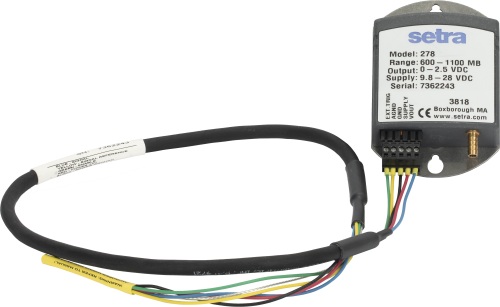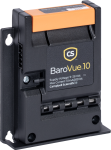
耐候性屋外収納ケース内に設置






概要
CS100 は、600 ~ 1100 hPa (mBar) の範囲の気圧を測定します。この範囲は、海面下 (鉱山など) から海抜 12,000 フィートまでの範囲に相当します。環境アプリケーションでの使用を目的に設計された CS100 は、すべての Campbell Scientific データロガーと互換性があります。
続きを読む利点と特徴
- Campbell Scientific の屋外収納ボックスに取り付けるよう最適化
- 低消費電力
- 3 年間保証
- 500 ~ 1100 hPa (mBar) および 800 ~ 1100 hPa (mBar) バージョンも特別注文で入手可能 - Campbell Scientific にお問い合わせください
- 一体型スイッチング回路により、測定サイクルの電力消費を制限
イメージ




詳細
CS100 は、圧力接続用の 1/8 インチのバーブフィッティングが取り付けられたステンレス鋼とポリエステルのケースに収められています。内部スイッチング回路が含まれ、データロガーは測定中のみ気圧計に電力を供給できるため、電力使用量が削減されます。
仕様
| 測定の説明 | 気圧 |
| 信号タイプ/出力 | アナログ電圧 |
| -注意- | 1 hPa = 1 mBar |
| 圧力範囲 | 600 ~ 1100 hPa |
| 長期安定性 | ±0.1 hPa / 年 |
| 応答時間 | < 100 ms |
| 分解能 | ±0.01 hPa |
| 励起 | 9.5 ~ 28 Vdc |
| 標高 | 海抜下約609.6メートル(2,000フィート)(鉱山内)から海抜約3,657.6メートル(12,000フィート)まで |
| 正確度 |
|
| 直線性 | ±0.4 hPa |
| ヒステリシス | ±0.05 hPa |
| 再現性 | ±0.03 hPa |
| 信号出力 | 0 ~ 2.5 Vdc |
| ウォームアップタイム | < 1 秒 |
| 外部トリガー電圧 |
|
| 消費電流 |
|
| 温度範囲 | -40° ~ +60°C |
| ケーブル径 | 0.8 cm (0.3 in.) |
| ケーブル長 | 0.8 m (2.5 ft) |
| 寸法 | 9.1 x 6.1 x 2.5 cm (3.6 x 2.4 x 1.0 in.) |
| 重さ | 135 g (4.8 oz) |
互換性
注意: 以下は代表的な互換性情報を示しています。互換性のある製品や互換性のない製品をすべて網羅したリストではありません。
Data Loggers
| 製品 | 互換性 | 注意 |
|---|---|---|
| CR1000 (リタイア) | ||
| CR1000X (リタイア) | ||
| CR300 (リタイア) | ||
| CR3000 (リタイア) | ||
| CR310 | ||
| CR350 | ||
| CR6 | ||
| CR800 (リタイア) | ||
| CR850 (リタイア) |
Distributed Data Acquisition
| 製品 | 互換性 | 注意 |
|---|---|---|
| Granite 6 (リタイア) |
互換性に関する追加情報
データロガーに関する考慮事項
取り付け
CS100 は通常、ENC12/14 以上の屋外収納ケース内のデータロガーの隣に取り付けられます。とても小さい ENC100 は、CS100 を専用の屋外収納ケースに別々に収納するために使用できます。
ドキュメント
よくある質問
CS100に関するよくある質問の数: 9
すべて展開すべて折りたたむ
-
ノイズの多い測定は、いくつかの要因によって発生する可能性があります。
- センサが十分に暖まらなかった。
- センサが電気的にノイズの多い環境に設置されているため、他のアナログ測定にノイズが混じる。
- センサまたはステーションの電源が汚れている。(クリーンな調整電圧がない。)
-
はい、ただし特定の条件が満たされた場合のみです:
- センサは結露しない環境に設置されています。
- 高湿度環境にアクセスする通気管は、水分がセンサのコンポーネントに届かないように、非常によく乾燥されています。センサに水分があると、センサが損傷し、修復不可能な状態になることがよくあります。
-
CS100 または CS106 のいずれかを ENC100 内に収めることができます。詳細については、ENC100 製品ページの仕様情報を参照してください。
-
ほとんどの場合、筐体や建物には、圧力が外圧と平衡を保つのに十分な小さな空間があります。したがって、センサを外部に排気する必要はありません。ただし、筐体内にあることで圧力が均等になる速度が遅くなることはありますが、速度の変化は通常顕著ではありません。
センサが完全に気密な環境にあり、この環境の外部の圧力を測定する必要がある場合は、センサを外部に排気する必要があります。ただし、外部に排気すると、筐体または関連する内部環境の定格が変わる可能性があります。
-
製造元は毎年の校正を推奨しています。ただし、公開されている規格や規制に準拠するには、より頻繁な校正が必要になる場合があります。
-
-
一般的に、これらのセンサは設置されている環境の圧力を測定するように設計されています。CS100 または CS106 は、筐体が雪から十分に密閉され、通気口が雪にアクセスできる状態であれば、積雪内の気圧を測定できます。ただし、これを実現するのは難しい場合があることに注意してください。
-
古いバージョンの Short Cut が使用されている可能性があります。最新バージョンの Short Cut をダウンロードしてください。
最新バージョンの Short Cut がすでにダウンロードされている場合は、プログラムを開いてください。
- [Tools] | [Options] に移動し、[Enable Creation of Custom Sensor Files] ボックスにチェックが入っていることを確認します。
- [Generic Measurements] フォルダで、センサに対して実行する測定の種類を右クリックし、[Create Custom Sensor] を選択します。
- センサの仕様に従ってフィールドを設定し、設定後にユーザーに表示する必要がないフィールドを非表示にして、[Save As] ボタンでカスタム センサ ファイル設定を保存します。
ケーススタディ
Tropical volcanic islands are biodiversity hotspots where the Critical Zone (CZ) remains poorly studied. In......続きを読む
エバーグレーズ国立公園は、米国最大の熱帯自然保護区で、南フロリダの湿地帯の脆弱な生態系を保護するために設立されました。この公園は、世界遺産、生物圏保護区、国際的に重要な湿地帯として同時に登録されている世界 3 か所のうちの 1 つです。エバーグレーズはビスケーン帯水層の涵養地帯の上にあり、南フロリダの淡水供給の大部分の源となっています。 1920 年代にフロリダ州マイアミの西に米国ハイウェイ 41 (「タミアミ トレイル」) が建設される前は、淡水はフロリダ州を南に自由に流れ、エバーグレーズの湿地帯に水を供給していました。タミアミ トレイルは実質的に水の流れを遮断し、水はマイアミやその他の近隣の都市に転用され、農業や住宅用に沼地を排水する計画が立てられました。公園内の淡水の水位が下がると、塩水が侵入し、エバーグレーズの生態系が損なわれ、公園内の生物多様性に悪影響を及ぼします。公園の生態系の保護に費やされた 1 ドルごとに 4 ドルの利益がもたらされると推定されています。 消滅しつつあるエバーグレーズを守るため、1930......続きを読む
ポン デル ペトロリは、タンカーから陸上への石油の移送を可能にするために 1960 年代に建設されました。桟橋はバルセロナに近いバダロナの砂浜付近の海上に約 250 メートル伸びています。プラットフォームは平均水面より 6 メートル上にあり、水深は最も深いところで 12 メートルです。 石油桟橋は 1990 年に産業用途から外れました。2001 年には、解体を避けて公共用途に再利用するよう国民から要望がありました。2002 年に......続きを読む
記事とプレスリリース
ニュースレター記事
Privacy Policy Update
We've updated our privacy policy. 詳細はこちら
Cookie Consent
Update your cookie preferences. クッキーの設定を更新する




